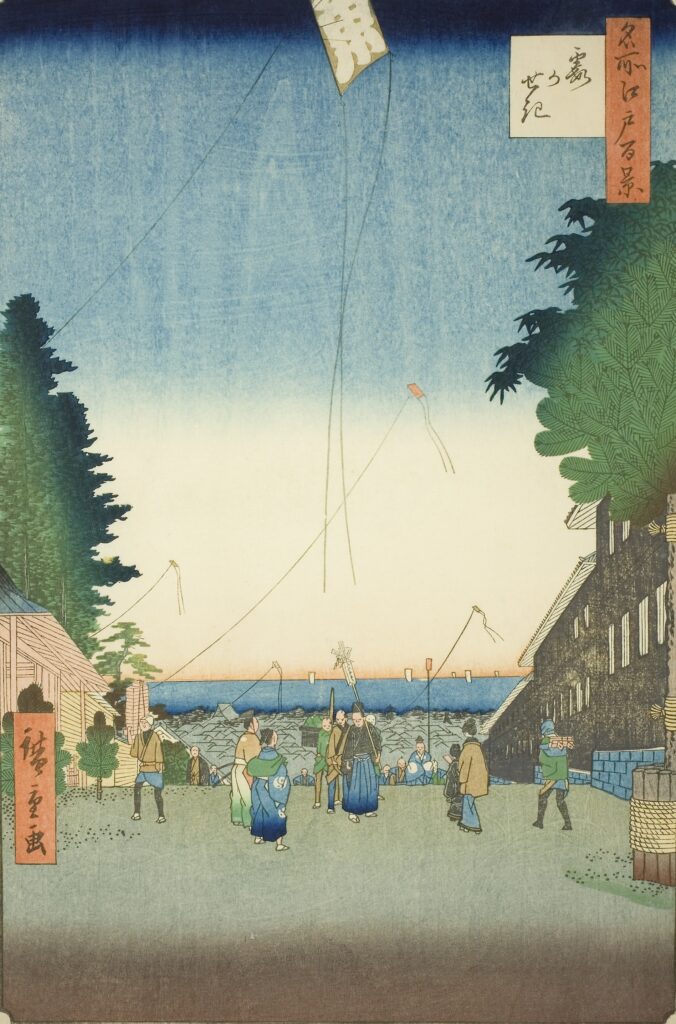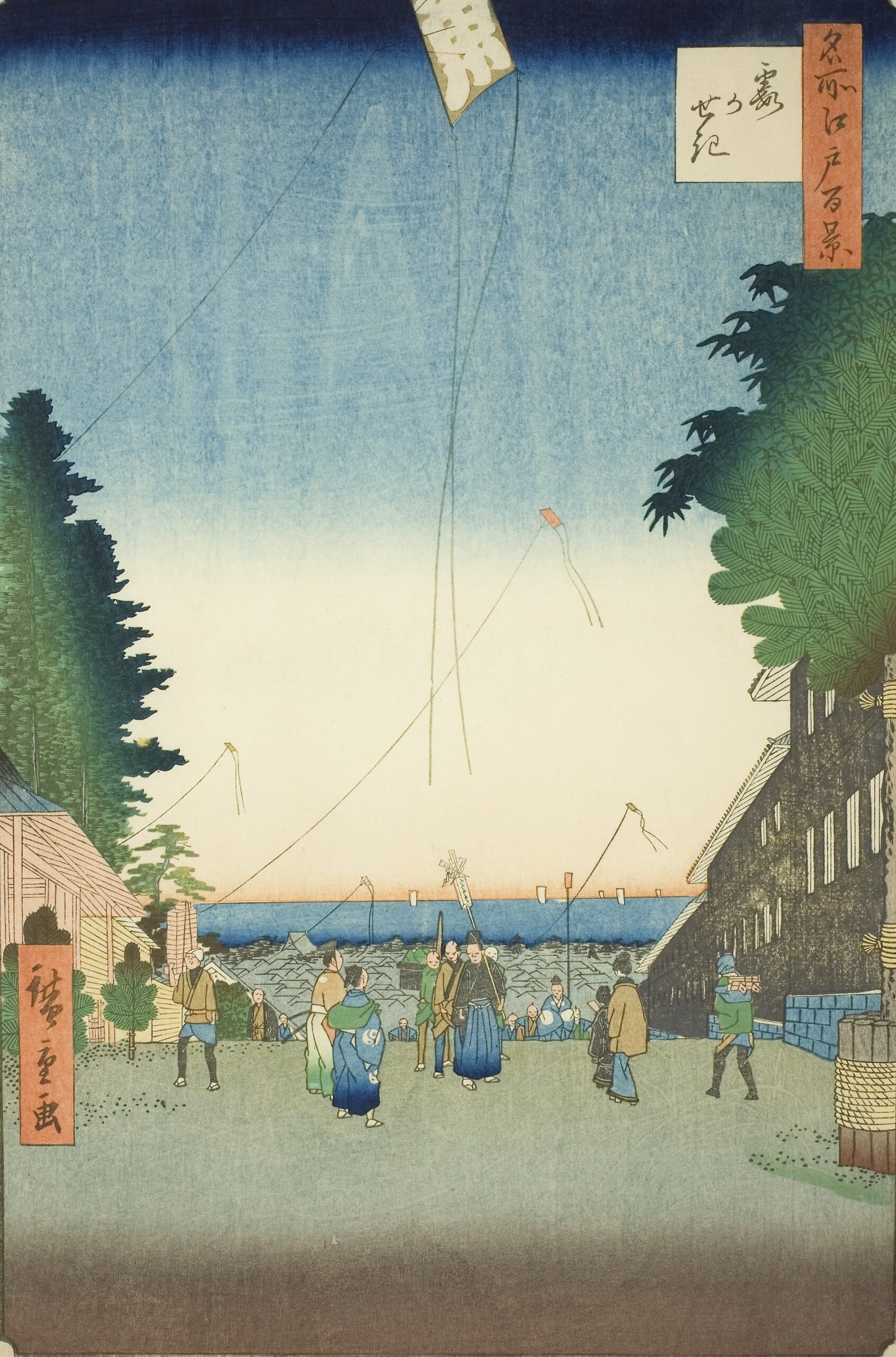
Utagawa Hiroshige – One Hundred Famous Views of Edo – 2 – Spring – Kasumigaseki
歌川広重-名所江戸百景-2-春-霞がせきの解説
Current Address: Kasumigaseki Hill, Kasumigaseki 2-chome, Chiyoda Ward
Latitude and Longitude: Latitude 35.6749, Longitude 139.7412
Published: January 1857 Age: 61
Description
■ Introduction
“Kasumigaseki” is a work depicting a corner of the government district near Edo Castle.
Although it is not a glamorous scene with snow or cherry blossoms, it is characterized by a bold composition that makes use of the perspective of the slope and the dignified atmosphere of the rows of samurai residences.
It has become beloved by many as a scene symbolizing the political and cultural center of Edo.
■ Kasumigaseki
This is the place where Emperor Yamato Takeru built a barrier as a defense against the Emishi of Oshu.
The view from here offers a panoramic view of the surrounding landscape, like a haze of clouds, hence the name “Kasumigaseki.”
During the Edo period, the main residence of Matsudaira Mino-no-kami (Kuroda family of the Fukuoka Domain) was located on the south side (right) across the slope of Kasumigaseki.
To the north side (left) was the main residence of Matsudaira Aki-no-kami (Asano family of the Hiroshima Domain).
Located south of the outer walls of Edo Castle and adjacent to gates (such as Sakuradamon and Toranomon), it was an important location from a defensive perspective.
During the Edo period, this area was lined with main residences of fudai daimyo and hatamoto (direct retainers of feudal lords).
The series of white walls and black fences on both sides of the slope were a spectacular sight, and were also seen as a symbol of authority for commoners.
After the Meiji Restoration, the samurai residences were demolished and the area was redeveloped into a government district.
Today, Kasumigaseki is the administrative center of Japan.
The hillside is lined with government offices, including the Ministry of Foreign Affairs, the Ministry of Finance, and the Ministry of Education, Culture, Sports, Science and Technology.
■ Highlights of the Painting
The slope is framed diagonally, creating a sense of perspective that draws the eye into the depths of the canvas.
The walls of the samurai residences towering on both sides rhythmically divide the canvas, creating a sense of grandeur and tension.
The pale tones of the sky evoke the hazy morning atmosphere.
The hazy distance and the soft transition of the eye from the foreground to the middle ground emphasize the depth of the slope.
Small figures of people resembling samurai and townspeople are depicted at the bottom of the canvas.
Even within this authoritative space, the everyday lives of common people and passersby are evident, conveying the real life of Edo.
The high walls and gates of the area convey the dignity of a key location within Edo Castle.
This dignified atmosphere has a different sense of tension than the cherry blossom viewing and famous landscapes depicted in ukiyo-e.
This is a New Year’s scene.
The paintings depict New Year’s customs, including “Samurai in Kamishimo making a New Year’s visit,” “A mother and child holding battledores,” “Kite flying,” “Kadomatsu (New Year’s pine decorations),” “Saizō and the tayu (court tasting),” “People singing Banzai (cheerful cheer),” “A gizzard shad sushi seller,” “Daikagura (traditional Japanese dance),” and “A shop selling unwanted fans at a fan box store.”
■ The appeal felt by the Edo commoners
Kasumigaseki was an inaccessible place for commoners.
It was a symbol of samurai society and a space distinct from everyday life.
Appreciating the “authority of Edo” through ukiyo-e was a kind of extraordinary experience for commoners.
The landscape created by the slopes and mist was not only the political center of Edo, but was also enjoyed purely as “beauty typical of Edo.”
The fantastical scenes of the seasonal mist rising must have captivated the hearts of people at the time.
■ Walking through modern-day Kasumigaseki
Modern-day Kasumigaseki is the administrative center of Japan.
Located close to the National Diet Building and the Supreme Court, this area is home to the political and judicial centers of Japan.
Information signs and stone monuments marking the remains of Edo-period residences remain in various locations, allowing visitors to stroll while imagining the tree-lined slopes of samurai residences depicted by Hiroshige.
The Edo Castle gates still remain in the area, conveying the atmosphere of the past.
Sakuradamon Gate, in particular, was the site of many historical events and is an important stop on your Kasumigaseki stroll.
■ Tourist Guide
① National Diet Building
This building symbolizes Japan’s political history since the Meiji era.
Even just viewing the exterior is impressive.
No reservations are required for individual tours of the interior.
Please apply on the day at the House of Councilors Visitor Reception Desk.
② Sakuradamon Gate
A valuable relic remaining as the outer gate of Edo Castle.
Enjoy a stroll through the historical area.
③ Hibiya Park
This green oasis, located right next to Kasumigaseki, is a perfect spot to stop by during your stroll.
④Ministerial Buildings
Compare the evolution of Japanese government buildings, from modern to contemporary architecture.


